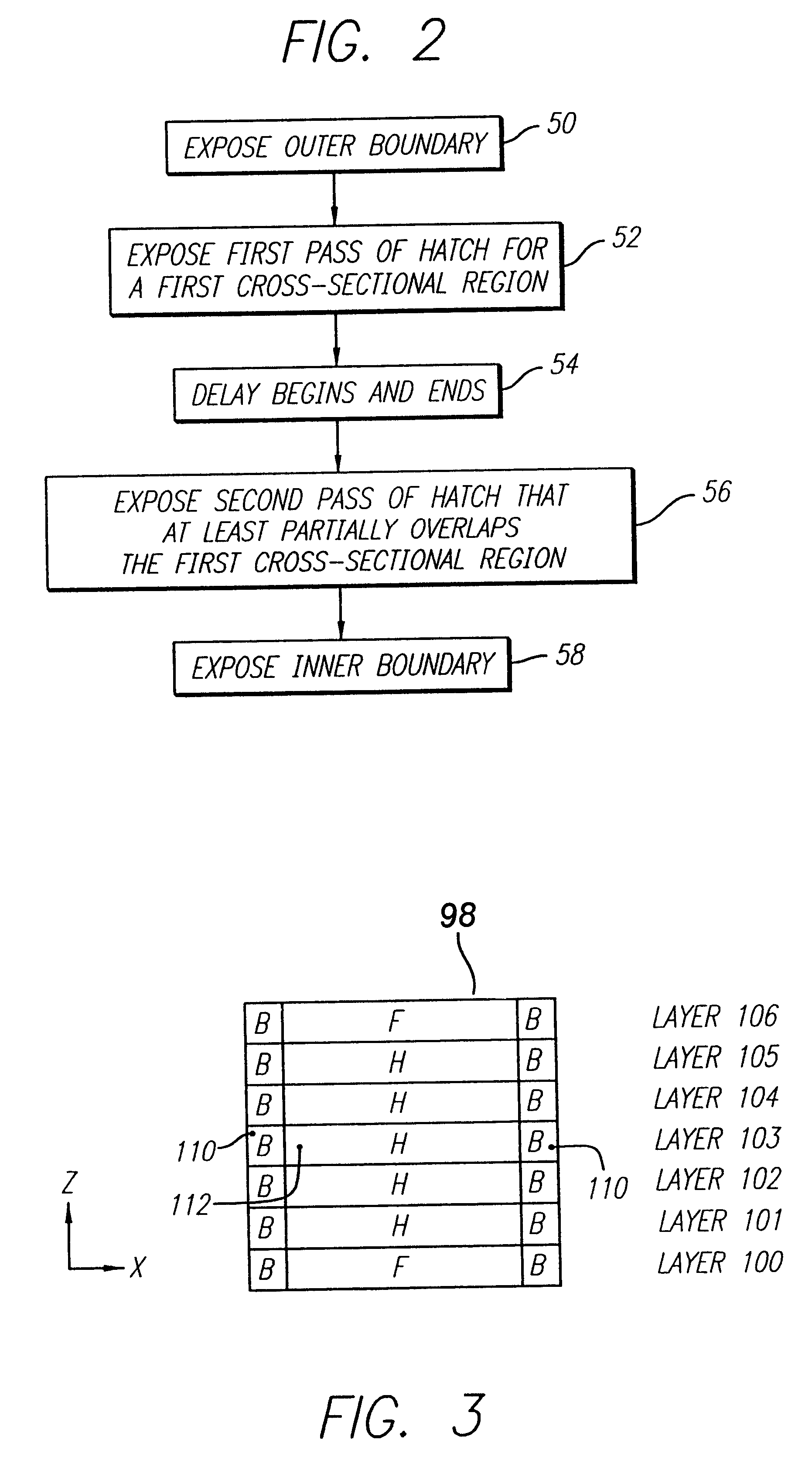Method and apparatus for stereolithographically forming three dimensional objects with reduced distortion
a three-dimensional object and distortion-reducing technology, applied in the field of methods and apparatus for forming three-dimensional objects with reduced distortion, can solve the problems of not teaching or suggesting failing to teach a step of ensuring enough time has passed, and the technique does not teach or suggest the partial creation of laminas
- Summary
- Abstract
- Description
- Claims
- Application Information
AI Technical Summary
Problems solved by technology
Method used
Image
Examples
first embodiment
The First Embodiment
The first preferred embodiment of the instant invention involves the formation of a single object on a platform. A first hatch vector pass of the laser beam scans the object cross-section along the X-axis. Upon completion of this pass, a delay period of 15 seconds begins. When the delay period ends, layer scanning begins with hatch vectors along the Y-axis. This embodiment is depicted in the flow chart of FIG. 2.
Referring now to FIG. 3, this process is described in more detail. FIG. 3 depicts a side view of an object 98 to be produced stereolithographically. In terms of forming horizontal layers, this figure depicts the vertical axis (Z) and one of the horizontal axes (X). As illustrated, the object 98 includes seven laminae, labeled 100-106 wherein each lamina includes a boundary region labeled B and a hatch region labeled H or a fill region labeled F. Object 98 will be used throughout the description of preferred embodiments of the instant invention to illustra...
second embodiment
The Second Embodiment
The second preferred embodiment of the instant invention is a continuation of the first embodiment as applied to the formation, on one platform, of more than one object, or an object or objects with multiple cross-sectional elements. In such a situation, the techniques described above in the first embodiment are simply followed for each object and / or cross-sectional element, in turn. The cure depth values, line width compensation values, and offset values used for lamina 103 in the first embodiment apply equally to the objects and cross-sectional elements of this embodiment. For clarity, this discussion will assume that two objects and / or cross-sectional elements are being built, and that they are both at a position composed of only continuing regions. The second embodiment is depicted in the flow chart of FIG. 4.
To begin, the outer boundary is completed for the first object and / or cross-sectional element (reference element 120, FIG. 4). Then the first and secon...
third embodiment
The Third Embodiment
The third preferred embodiment of the instant invention is also a continuation of the first embodiment as applied to the formation, on one platform, of more than one object, or an object or objects with multiple cross-sectional elements. Therefore, this embodiment is, in effect, an alternative to the second embodiment. The cure depth values, line width compensation values, and offset values used for lamina 103 in the first embodiment apply equally to the objects and cross-sectional elements of this embodiment. For clarity, this discussion will assume that two objects and / or cross-sectional elements are being built, and that they are both at a position composed of only continuing regions.
A first implementation of the third embodiment is depicted in the flow chart of FIG. 5. First, the outer boundary 150 of the first object and / or cross-sectional element is drawn. Then the outer boundary 152 of the second object / element is completed. Next, the first pass of hatch v...
PUM
| Property | Measurement | Unit |
|---|---|---|
| Time | aaaaa | aaaaa |
| Time | aaaaa | aaaaa |
| Time | aaaaa | aaaaa |
Abstract
Description
Claims
Application Information
 Login to View More
Login to View More - R&D
- Intellectual Property
- Life Sciences
- Materials
- Tech Scout
- Unparalleled Data Quality
- Higher Quality Content
- 60% Fewer Hallucinations
Browse by: Latest US Patents, China's latest patents, Technical Efficacy Thesaurus, Application Domain, Technology Topic, Popular Technical Reports.
© 2025 PatSnap. All rights reserved.Legal|Privacy policy|Modern Slavery Act Transparency Statement|Sitemap|About US| Contact US: help@patsnap.com



